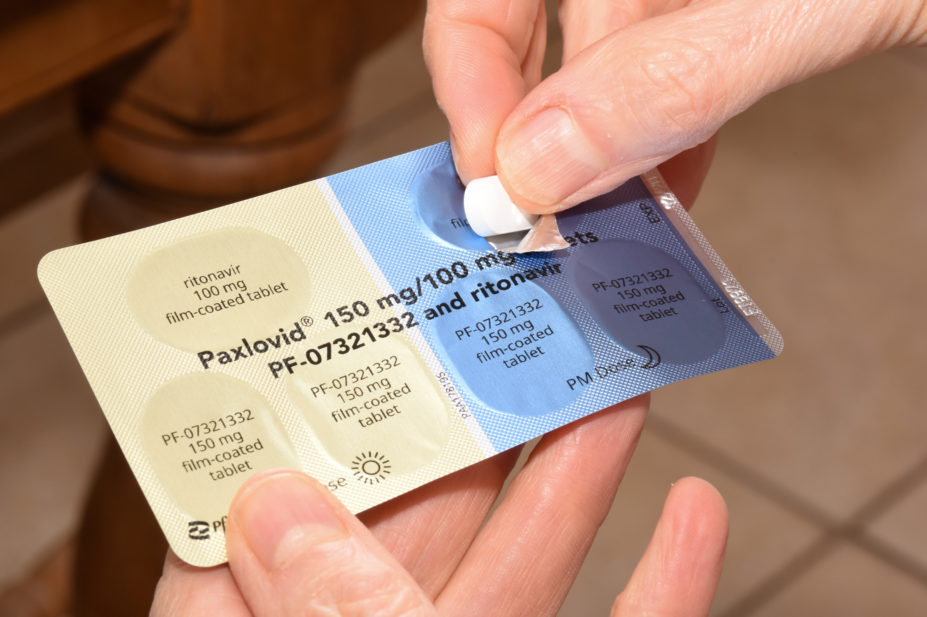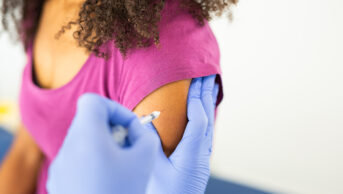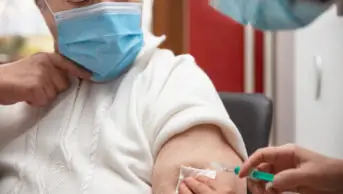
DR P. MARAZZI/SCIENCE PHOTO LIBRARY
A small number of patients treated with Pfizer’s antiviral, Paxlovid, for mild-to-moderate COVID-19 infection have been reported to experience a sudden rebound in symptoms and viral load after completing the treatment regimen. The issue is receiving attention in the United States, with some experts advising that healthcare providers should warn patients to watch for COVID-19 symptoms after taking Paxlovid and test again if they begin to feel ill. But is this a sign that SARS-CoV-2 virus is developing resistance to the antiviral and should we be taking extra measures to protect vulnerable patients in the UK?
What is post-Paxlovid viral rebound?
According to reports in the United States, cases of relapse have involved patients who have taken Paxlovid after testing positive for COVID-19, who subsequently test negative after completing the recommended five-day course of treatment, only to test positive again several days afterwards.
A pre-print of a case study, published on 26 April 2022, contains details of Paxlovid rebound in a 71-year-old, fully vaccinated and boosted male with intermittent asthma[1]. In this individual, symptoms improved rapidly after the start of treatment, with complete resolution on day two of treatment. However, on day 9, while still isolating, he developed cold symptoms that did not resolve until day 12. COVID-19 testing revealed two distinct peaks of viral load on day one and nine.
The authors acknowledged that it was not possible to know if rebound occurred more frequently during treatment with Paxlovid compared with untreated patients, but said that the potential for symptomatic rebound of viral load, with or without antiviral treatment, had “important implications” for clinical management and infection prevention.
How often has this happened in the UK?
We do not know for sure; however, a statement from the Medicines and Healthcare products Regulatory Agency (MHRA), shared with The Pharmaceutical Journal on 12 May 2022, said the organisation had received “a small number” of Yellow Card reports of individuals who have tested positive after completing treatment with Paxlovid.
“This is in line with that seen in the clinical trials in which 1–2% of patients continued to test positive on PCR after a course of treatment in both arms of the trial. This could be due to a number of reasons,” the statement continued.
It is important to note that a report of a suspected side effect to the Yellow Card scheme does not necessarily mean that it was caused by the treatment, only that the reporter has a suspicion that it may have been.
Did we know about the potential for this when Paxlovid was approved?
Penny Ward, visiting professor in pharmaceutical medicine at King’s College London, highlights that Pfizer’s initial submission to the US Food and Drug Administration (FDA) did suggest that some individuals taking Paxlovid experienced a regrowth of virus at the end of treatment[2]. However, as they did not report clinical data, the link with these “recrudescent symptoms” was not transparent.
In Pfizer’s EPIC-HR study, some patients (1–2%) had one or more positive SARS-CoV-2 PCR tests after testing negative, or an increase in the amount of SARS-CoV-2 detected by PCR, 10–14 days after completing their treatment course compared with at completion of treatment on day 5.
However, a spokesperson for Pfizer told The Pharmaceutical Journal that these cases occurred at similar rates between those who received treatment with Paxlovid and those who received placebo, and there did not appear to be an association between the observed viral load increase and subsequent severe disease.
The principle concern would be the potential that this is linked to emergent resistant virus during treatment, with a second episode of disease caused by the resistant viral strain
Penny Ward, visiting professor in pharmaceutical medicine at King’s College London
“Although it is too early to determine the cause, this suggests the observed increase in viral load is both uncommon and not uniquely associated with treatment,” they said.
“Additionally, the vast majority of patients in EPIC-HR demonstrated sustained reductions in viral load through day 14, following completion of treatment.
Ward explains that it is not “entirely unusual” to see ‘double bump’ viral load in some patients treated with antivirals.
“Particularly if these are individuals who may be relatively immune suppressed, either because of disease or other co-administered drugs.
“But, the principle concern would be the potential that this is linked to emergent resistant virus during treatment, with a second episode of disease caused by the resistant viral strain.”
This, Ward explains, had been observed in some trials with influenza antivirals.
Why is this happening?
There are a few theories as to why viral rebound might occur but more research will be needed to confirm the exact mechanism.
Ward says that the target group for the COVID-19 antivirals in the UK — individuals who are likely to be immune suppressed, such as patients with cancer or immune deficiency disorders — might actually increase the potential for viral rebound to happen.
“[These] individuals may not be able to clear the virus as well as individuals with a normal functioning immune system and, in the absence of viral clearance, re-emergence of virus once the antiviral is removed would be anticipated. This may be what is being observed here.”
As Stephen Griffin, associate professor in the school of medicine at the University of Leeds, points out, direct-acting antivirals, such as Paxlovid, work by suppressing rather than eliminating the virus.
The balance may be tipped in favour of viral relapse more often than we might realise
Stephen Griffin, associate professor in the school of medicine at the University of Leeds
“You still require your immune system to kill cells harbouring the viral RNA/proteins,” he adds.
“The fact that we only use a five-day course and this is primarily in people that are vulnerable/immunocompromised possibly means that the balance may be tipped in favour of viral relapse more often than we might realise.”
Another potential hypothesis is that rebounding is occurring more often because of the new BA.2 Omicron variant of COVID-19 – which was not circulating when the Paxlovid clinical trials were carried out.
Is this a sign that SARS-CoV-2 is developing resistance to Paxlovid?
While further evaluation is needed, a spokesperson for Pfizer told The Pharmaceutical Journal that it had not seen any resistance emerge to date in patients treated with Paxlovid. In the clinical trial, rebound occurred among subjects both with and without potential resistance-associated mutations, detected at day one and day five, suggesting that the rebound was not down to antiviral resistance[2].
“We continue to monitor data from our ongoing clinical studies and post-authorisation safety surveillance,” the spokesperson added.
“We remain very confident in its clinical effectiveness at preventing severe outcomes from COVID-19 in high-risk patients.”
Ward concurs: “To date, there are no current reports of emergence of resistant strains; instead, these instances of rebound appear to be due to emergence of the initial infection within a timeframe suggesting recrudescence in individuals that have not completely cleared the original infection.”
However, as Griffin explains, this does not mean that resistance is not a possibility.
“We … need to be very careful about embarking upon prolonged treatment in immunocompromised patients … because if the virus isn’t cleared, continuing to replicate in that patient, then resistance may occur over time.
“Such mutations are likely to be detrimental at first, but in time it may also evolve compensatory mutations that restore fitness to drug-resistant virus,” he adds.
Is there anything we can do to treat patients who relapse or to prevent this from happening?
In an interview on 3 May 2022, Albert Bourla, chief executive of Pfizer, suggested that people experiencing post-Paxlovid viral rebound could simply take another course of treatment. However, this idea was quickly rebuked by the FDA.
In a post published on 5 May 2022, John Farley, director of the Office of Infectious Diseases at the FDA, said there was “no evidence of benefit at this time for a longer course of treatment” or for repeating a treatment course of Paxlovid in patients with recurrent COVID-19 symptoms following completion of a treatment course.
Currently, the advice from the FDA is that healthcare professionals and patients should wear a mask and isolate if they have any symptoms, regardless of whether or not they have been treated with an antiviral agent.
The MHRA told The Pharmaceutical Journal that it advised patients and their carers to speak to a healthcare professional if they develop symptoms of COVID-19 following treatment with Paxlovid.
Ward suggests that increasing the timeframe for treatment could work in cases of patients rebounded, but adds that it might also be effective to combine treatment with a neutralising antibody therapy, to assist with viral clearance.
We also ought to maintain testing and isolation periods for people on therapy … the notion that we needn’t suppress transmission is fundamentally flawed
Stephen Griffin, associate professor in the school of medicine at the University of Leeds,
“This could be particularly helpful in patients with any degree of immune suppression,” she adds.
Griffin suggests that “one solution” would be to learn from the treatment of chronic viral infections, such as HIV, which, like cancers that can also evolve resistance, are treated with combination antiviral chemotherapy.
“This has not been adopted for the treatment of acute diseases as far as I know, but I would urge that it needs to happen with SARS-CoV2 before long.”
He adds that there is a need to use these drugs “intelligently” and only in the patients the really need them.
“We also ought to maintain testing and isolation periods for people on therapy … the notion that we needn’t suppress transmission is fundamentally flawed.”
So, should we be worried?
At the moment, it appears that rebound is only happening in a small number of patients and we will have to wait for further research to be carried out to find out the exact mechanism as to why this happens.
“What we’re doing with the antivirals is essentially … reducing the chances of the virus getting ahead of a potentially weakened immune response and developing severe COVID,” says Griffin. However, he adds that there is an “urgent” need to establish if relapsing patients go on to develop severe symptoms, possibly leading to hospitalisation.
“We also need to act pre-emptively to minimise relapse wherever possible.
Based on the data available to us, the balance of benefits and risks for Paxlovid remains favourable for the authorisation indication
Medicines and Healthcare products Regulatory Agency
“If we don’t, there’s a risk that resistance might arrive more quickly than we’d hoped.”
Overall, it is important to emphasise that these reports do not change the conclusions from the Paxlovid clinical trial, which suggested that in non-hospitalised patients at high risk of progression to severe COVID-19, treatment within five days of symptom onset with Paxlovid reduced the risk of hospitalisation or death by 88%, although this was in an unvaccinated population.
“The endpoint for the [Paxlovid] trials was keeping people out of hospital, not eliminating infection,” says Griffin.
In its statement, the MHRA said that, as part of its “ongoing rigorous safety monitoring,” it would “closely review” the Yellow Card reports submitted in the UK alongside safety data from other countries.
“Based on the data available to us, the balance of benefits and risks for Paxlovid remains favourable for the authorisation indication,” the statement added.
“Patient safety is our top priority.”
- 1Gupta K, Strymish J, Stack G, et al. Rapid Relapse of Symptomatic SARS-CoV-2 Infection Following Early Suppression with Nirmatrelvir/Ritonavir. 2022. doi:10.21203/rs.3.rs-1588371/v1
- 2Emergency Use Authorization (EUA) for Paxlovid (nirmatrelvir tablets co’packaged with ritonavir tablets) Center for Drug Evaluation and Research (CDER) Review. US Food and Drug Administration . 2021.https://www.fda.gov/media/155194/download (accessed 17 May 2022).


